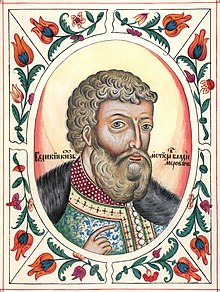Mstislav I of Kiev
| Mstislav I Monomakh | |
|---|---|
 Portrait in the Tsarsky titulyarnik (1672) | |
| Grand Prince of Kiev | |
| Reign | 1125–1132 |
| Predecessor | Vladimir II |
| Successor | Yaropolk II |
| Born | February 1076 Turov |
| Died | 15 April 1132 (aged 55) Kiev |
| Spouse | Christina Ingesdotter of Sweden Liubava Dmitrievna Zavidich |
| Issue | Ingeborg of Kiev Malmfred of Kiev Dobrodeia of Kiev Vsevolod of Pskov Maria Mstislavna of Kiev Iziaslav II of Kiev Rostislav of Kiev Sviatopolk of Pskov Rogneda Xenia Vladimir III of Kiev Euphrosyne of Kiev |
| Dynasty | Rurik |
| Father | Vladimir II Monomakh |
| Mother | Gytha of Wessex |
Mstislav I Vladimirovich Monomakh (Old East Slavic: Мьстиславъ Володимѣровичъ Мономахъ, romanized: Mĭstislavŭ Volodiměrovičŭ Monomakhŭ;[a] Christian name: Fedor;[1][2] February 1076 – 14 April 1132), also known as Mstislav the Great, was Grand Prince of Kiev from 1125 until his death in 1132. After his death, the state began to quickly disintegrate into rival principalities.
He was the eldest son of Vladimir II Monomakh by Gytha of Wessex.[3] He is figured prominently in the Norse Sagas under the name Harald, to allude to his grandfather, Harold II of England.
Biography
[edit]Mstislav was born in Turov. As his father's future successor, he reigned in Novgorod from 1088 to 1093 and (after a brief stint at Rostov) from 1095 to 1117. Thereafter, he was Monomakh's co-ruler in Belgorod Kievsky, and inherited the Kievan throne after his death. He built numerous churches in Novgorod, of which St. Nicholas Cathedral (1113),[4] and the cathedral of St Anthony Cloister (1117) survive to the present day. Later, he would also erect important churches in Kiev, notably his family sepulchre at Berestovo and the church of the Assumption of the Mother of God in Podol.[5]

Mstislav's life was spent in constant warfare with the Cumans (1093; 1107; 1111; 1129), Estonians (1111; 1113; 1116; 1130), Lithuanians (1131), and the princedom of Polotsk (1127; 1129). In 1096, he defeated his uncle Oleg of Chernigov on the Koloksha River, thereby laying foundation for the centuries of enmity between his and Oleg's descendants. Mstislav was the last ruler of a unified state, and upon his death, as the chronicler put it, "the land of Rus was torn apart".[6] He died in Kiev, aged 55.
After his death, the state began to quickly disintegrate.[7] At the time of Monomakhs's death, there had been only two main groups in the princely family, the Monomakhovichi and Olgovichi, but as the family proliferated, it broke up into a number of local branches and sub-branches.[8]
He was canonized as a saint by the Russian Orthodox Church and is commemorated on 15 April in the Eastern Orthodox Church.[9][10]
Family
[edit]In 1095, Mstislav married Princess Christina Ingesdotter of Sweden, daughter of King Inge I of Sweden.[11] They had:
- Ingeborg of Kiev, married Canute Lavard of Jutland,[12] and was mother to Valdemar I of Denmark
- Malmfred, married (1) Sigurd I of Norway; (2) Eric II of Denmark[13]
- Eupraxia, married Alexius Comnenus, son of John II Comnenus
- Vsevolod of Novgorod and Pskov[14]
- Maria Mstislavna of Kiev, married Vsevolod II of Kiev
- Iziaslav II of Kiev
- Rostislav of Kiev
- Sviatopolk of Pskov
- Rogneda, married Yaroslav of Volhynia
- Xenia, married Briachislav of Izyaslavl
Christine died on 18 January 1122. Later that year Mstislav married again, to Liubava Dmitrievna Zavidich, the daughter of Dmitry Saviditsch, a nobleman of Novgorod. Their children were:
- Vladimir III Mstislavich (1132–1171)
- Euphrosyne of Kiev, (c. 1130 – c. 1193) married King Géza II of Hungary in 1146.
Notes
[edit]References
[edit]- ^ Biographischer Index Rußlands und der Sowjetunion (in Russian). Walter de Gruyter. 31 October 2011. p. 1417. ISBN 978-3-11-093336-9.
- ^ Litvina, A. F.; Uspensky, F. B. (2006). Выбор имени у русских князей в X—XVI вв. Династическая история сквозь призму антропонимики. Indrik. p. 581. ISBN 5-85759-339-5.
- ^ Philip Line, Kingship and State Formation in Sweden 1130-1290, (Brill, 2007), 597.
- ^ George Heard Hamilton, The Art and Architecture of Russia, (Yale University Press, 1983), 43.
- ^ Dimnik, Martin (1994). The dynasty of Chernigov. 1054-1146. Toronto: Pontifical Institute of Mediaeval Studies. p. 389. ISBN 0888441169.
- ^ Соловьев, Сергей Михайлович (1976). History of Russia. Academic International Press. p. 92. ISBN 978-0-87569-238-8.
- ^ Fennell, John (13 October 2014). The Crisis of Medieval Russia 1200-1304. Routledge. p. 5. ISBN 978-1-317-87314-3.
- ^ Auty, Robert; Obolensky, Dimitri (1976). Companion to Russian Studies: Volume 1: An Introduction to Russian History. Cambridge University Press. p. 72. ISBN 978-0-521-28038-9.
- ^ "Святой благоверный великий князь Мстислав Владимирович + Православный Церковный календарь". days.pravoslavie.ru.
- ^ "Commemoration of the Vladimir Icon of the Mother of God and the deliverance of Moscow from the Invasion of Tamerlane". www.oca.org.
- ^ Dvornik 1947, p. 41.
- ^ Line 2007, p. 591.
- ^ Line 2007, p. 597.
- ^ Line 2007, p. 603.
Sources
[edit]- Dvornik, F. (1947). "The Kiev State and Its Relations with Western Europe". Transactions of the Royal Historical Society. 29.
- Line, Philip (2007). Kingship and State Formation in Sweden: 1130 - 1290. Brill.
